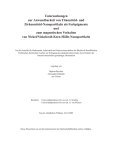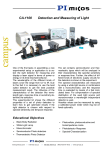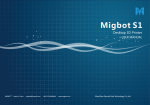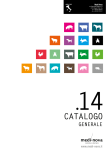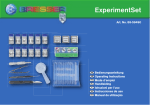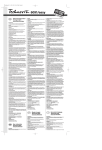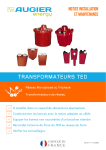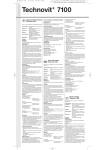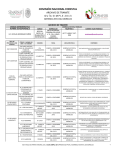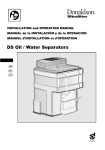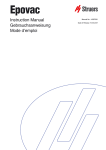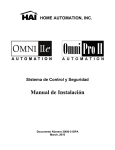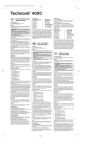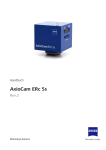Download 7200/7210/7230 VLC - bei Heraeus Kulzer Technik
Transcript
7200/7210/7230 VLC Gebrauchsinformationen Technovit 7200/7210/7230 VLC Technovit 7200 VLC Lichthärtender Einkomponentenkunststoff auf Methacrylatbasis zum Einbetten und anschließendem Anfertigen von Dünnschliffen in Medizin und Zahnmedizin. Technovit 7210 VLC Lichthärtender Einkomponentenpräzisionskleber auf Methacrylatbasis zur Präzisionsklebung der ausgehärteten Proben auf einem Acrylglasobjektträger. Technovit 7230 VLC Lichthärtender Einkomponentenkleber auf Methacrylatbasis zur Fixierung der Gewebeprobe in der Einbettmulde. Eigenschaften Technovit 7200 VLC wurde speziell für die Dünnschliff-Technik entwickelt. Es durchdringt vollständig das Hartgewebe, eine Entkalkung des Gewebes ist bei dieser Technik nicht erforderlich. Kunststoffe wie z. B. Composite-Zahnfüllungen oder Knochenzemente werden von Technovit 7200 VLC nicht angegriffen. Die Aushärtung des Einbettmediums erfolgt im Blaulichtgerät. Bei Einhaltung der angegebenen Bestrahlungszeiten wird die Temperatur von 40 °C nicht überschritten. Aufgrund seiner mechanischen Festigkeit eignet sich Technovit 7200 VLC, hervorragend für die Dünnschliff-Technik. Die Säge- und Schleifeinheit der Firma Exakt ist hierfür besonders geeignet. Einfärben ist nach allen bekannten Methoden in kurzer Zeit und hoher Qualität möglich. Verarbeitung Fixation Für dieses lichthärtende Einbettsystem ist jegliche, für die Lichtmikroskopie übliche Fixation möglich. Entwässerung Die Entwässerung des Gewebes ist über eine aufsteigende Glykolmethacrylat- oder AIkoholreihe möglich. Beispiel Glykolmethacrylat/Wasser Glykolmethacrylat/Wasser Glykolmethacrylat/Wasser Glykolmethacrylat Glykolmethacrylat Glykolmethacrylat = 70/30 = 80/20 = 90/10 = 100 = 100 = 100 3 Stunden 3 Stunden 3 Stunden 3 Stunden 3 Stunden 3 Stunden Infiltration Die Infiltration wird mit einem Gemisch Alkohol/ Technovit 7200 VLC = 1/1 bei der Alkoholreihe oder Glykolmethacrylat/Technovit 7200 VLC = 1/1 bei der Glykolmethacrylatreihe eingeleitet. Anschließend wird mit reinem Technovit 7200 VLC infiltriert. Bei apparativer Entwässerung und Infiltration mit Agitation und Vakuum sind Entwässerungszeiten von 3 Stunden pro Stufe und Infiltrationszeiten von 8 Stunden pro Stufe bei 2 bis 3 mm dicken Gewebescheiben ausreichend. Bei Entwässerung und Infiltration ohne Agitation und Vakuum müssen die Zeiten pro Stufe etwa vervierfacht werden. Die Infiltration muss in lichtundurchlässigen Gefäßen bzw. Automaten erfolgen, da sonst durch Lichteinfall die Polymerisation gestartet wird. Einbettung Zur planparallelen Einbettung wird die vorbereitete, infiltrierte Gewebeprobe in die entsprechende Einbettform auf einen vorher eingebrachten Tropfen Fixierungskleber Technovit 7230 VLC gelegt und leicht angedrückt. Es ist darauf zu achten, dass die zu untersuchende Fläche nach unten gelegt wird. Danach wird die Gewebeprobe mit Technovit 7200 VLC so übergossen, dass das Gewebe nicht aufschwimmt und dass keine Luftblasen eingeschlossen werden. Polymerisation Die Polymerisation der Einbettung erfolgt im Blaulichtgerät. Die Polymerisation wird in zwei Stufen durchgeführt. Während der ersten Polymerisationsstufe wird das Einbettmedium weitgehend polymerisiert. Dies erfolgt bei niedriger Lichtintensität, damit die Polymerisationstemperatur 40 °C nicht übersteigt und keine Spannungsrisse entstehen. In der zweiten Polymerisationsstufe wird bei hoher Lichtintensität das im Gewebe infiltrierte Einbettmaterial vollständig polymerisiert. Die Gesamtpolymerisationszeit beträgt maximal 6 Stunden. Die Polymerisationstemperatur übersteigt bei maximal 40 ml Einbettmedium und bei einer Raumtemperatur von 23 °C nicht die Temperatur von 40 °C. Präzisionsklebung Die Präzisionsklebung der Gewebeprobe auf einem Acrylglasobjektträger erfolgt mit dem lichthärtenden Präzisionskleber Technovit 7210 VLC. Die Photopolymerisation des Klebers wird in der Präzisions-Klebepresse der Firma Exakt durchgeführt und ist nach 15 Minuten Bestrahlungszeit abgeschlossen. Einfärbung Nach allen üblichen Färbemethoden möglich. Gefahrenhinweise/Sicherheitsratschläge Bitte beachten Sie die Hinweise auf den Produktverpackungen und Sicherheitsdatenblättern. www.kulzer-technik.de Aufbewahrungshinweise Behältnisse stets geschlossen aufbewahren. Nicht über Raumtemperatur lagern. Nach Ablauf des Verfalldatums sollte das Material nicht mehr verwendet werden. Nicht in die Hände von Kindern gelangen lassen. Liefereinheiten Technovit 7200 VLC 1000 ml Flüssigkeit Technovit 7210 VLC 2 x 15 ml Flüssigkeit Technovit 7230 VLC 100 ml Sirup Dyeing Possible with all customary dyeing methods. Unsere anwendungstechnische Beratung in Wort, Schrift und durch Versuche erfolgt nach bestem Wissen, gilt jedoch nur als unverbindlicher Hinweis, auch in Bezug auf etwaige Schutzrechte Dritter und befreit Sie nicht von der eigenen Prüfung der von uns gelieferten Produkte auf ihre Eignung für die beabsichtigten Verfahren und Zwecke. Anwendung, Verwendung und Verarbeitung der Produkte erfolgen außerhalb unserer Kontrollmöglichkeiten und liegen daher ausschließlich in Ihrem Verantwortungsbereich. Selbstverständlich gewährleisten wir die einwandfreie Qualität unserer Produkte nach Maßgabe unserer Allgemeinen Verkaufs- und Lieferbedingungen. User instructions Technovit 7200/7210/7230 VLC Technovit 7200 VLC Photocuring one-component methacrylate-based resin for embedding and subsequent production of thin ground sections in medicine and dentistry. Technovit 7210 VLC Photocuring one-component precision adhesive on the basis of methacrylate for precision adhesion of polymerized specimens on acrylic glass specimen holders. Danger/Safety advices Please follow the instructions on the product packaging and safety data sheets. www.kulzer-technik.com Storage advice: Keep vessels always closed. Not store above room temperature. After expiry date the materials should not be used anymore. Keep away from reach of children. Delivery units Technovit 7200 VLC 1000 ml liquid Technovit 7210 VLC 2 x 15 ml liquid Technovit 7230 VLC 100 ml sirup Our technical advice, whether verbal, in writing or by way of trials, is given in good faith but without warranty, and this also applies where proprietary rights of third parties are involved. It does not release you from the obligation to test the products supplied by us as and to their suitability for the intended processes and uses. The application, use and processing of the products are beyond our control, and therefore, entirely your own responsibility. Should, in spite of this, liability be established for any damage, it will be limited to the value of the goods delivered by us and used by you. We will, of course, provide consistent quality of our products within the scope of our General Conditions of Sale and Delivery. Technovit 7230 VLC Photocuring one-component adhesive methacrylate-based, for the fixing of tissue specimens in the embedding mould. Properties Technovit 7200 VLC was specially developed for the thin grinding technique. It completely penetrates hard tissue, and with this technique no decalcification of the tissue is necessary. Resins like composite tooth filling materials or bone cements are not affected by Technovit 7200 VLC. Polymerization of the embedding medium takes place in the blue light unit. When adhering to the irradiation times indicated, temperatures will not exceed 40 °C. Its mechanical strength makes Technovit 7200 VLC particularly suitable for the thin grinding technique, and the sawing and grinding equipment manufactured by Exakt is best suited for this method. All customary dyeing methods may be applied with high-quality results and in a minimum of time. Handling Fixation Any fixation method customary in light microscopy may be used for this photocuring embedding system. Dehydration Dehydration of the tissue may be done via an ascending glycolmethacrylate or alcohol range. Example Glycolmethacrylate/Water Glycolmethacrylate/Water Glycqlmethacrylate/Water Glycolmethacrylate Glycolmethacrylate Glycolmethacrylate = 70/30 = 80/20 = 90/10 =100 =100 =100 3 hours 3 hours 3 hours 3 hours 3 hours 3 hours Infiltration Infiltration is initiated with a mixture of alcohol/ Technovit 7200 VLC = 1/1 in the alcohol range or glycolmethacrylate/Technovit 7200 VLC = 1/1 in the glycolmethacrylate range, followed by infiltration with pure Technovit 7200 VLC. If dehydration is done mechanically and the infiltration with agitation and vacuum, dehydration times of 3 hours per stage and infiltration times of 8 hours per stage will suffice for tissues of 2 to 3 mm thickness. For dehydration and infiltration without agitation and vacuum the times per stage should be multiplied by four. Infiltration should take place in light-proof containers or equipment as contact with light will start the polymerization. Embedding For planeparallel embedding the prepared and infiltrated tissue specimen is placed in the embedding mould on a drop of fixation adhesive Technovit 7230 VLC and gently pressed down. It is important that the surface to be examined should be on the bottom of the mould. Then Technovit 7200 VLC is poured onto the specimen in such a manner that the specimen does not float and no air bubbles are entrapped. Polymerization The polymerization of the embedding takes place in the blue light unit in two stages. During the first stage the embedding medium is polymerized almost completely at a low light intensity so that the polymerization temperature does not exceed 40 °C and no cracks will form. The final polymerization of the embedding material infiltrated in the tissue is done at high light intensity during the second stage. Total po!ymerization time is 6 hours max. If a maximum of 40 ml embedding rnedium is used at an ambient temperature of 23 °C, polymerization temperature will not exceed 40 °C. Precision adhesion The precision adhesion of tissue specimens to an acrylic glass specimen holder is done with the photocuring precision adhesive Technovit 7210 VLC. The photopolymerization of the adhesive takes place in the precision adhesion press manufactured by Exakt and is finalized after 15 minutes irradiation time. Mode d’emploi Technovit 7200/7210/7230 VLC Technovit 7200 VLC Résine photopolymérisable à un composant à base de méthacrylate pour la technique de coupe mince après enrobage en médecine et en dentisterie. Technovit 7210 VLC Colle de précision photopolymérisable à un composant à base de méthacrylate pour les collages de précision d’échantillons durcis sur un porte-objet de plexiglas. Technovit 7230 VLC Colle photopolymérisable à un composant à base de méthacrylate pour fixer les échantillons durcis sur les moufles. Caracteristiques Technovit a été spécialement conçu pour la technique de la coupe mince. II pénètre complètement le tissu dur et cette technique n'exige pas de décalcification du tissu. Les résines comme par exemple les obturations dentaires en composite ou les ciments d'os ne sont pas attaqués par Technovit 7200 VLC. Le durcissement de la masse mise en moufle se fait dans le générateur de lumière bleu. Si l'on respecte les temps d'exposition indiqués, la température de 40 °C n'est pas dépassée. En raison de sa résistance mécanique Technovit 7200 VLC convient parfaitement à la technique de la coupe mince. L'unité de sciage et de coupe de la société Exakt est particulièrement conseillée ici. On peut effectuer une coloration rapide et d'excellente qualité en utilisant les méthodes courantes. Mise en œuvre Fixation Toutes les fixations courantes utilisées pour les microscopes optiques sont utilisables pour ce système d'enrobage photopolymérisable. Assèchement L'assèchement du tissu est possible par une série ascendante d’alcools ou de méthacrylates de glycol. Exemple methacrylate de glyco/eau methacrylate de glyco/eau methacrylate de glyco/eau methacrylate de glycol methacrylate de glycol methacrylate de glycol = 70/30 = 80/20 = 90/10 = 100 = 100 = 100 3 heures 3 heures 3 heures 3 heures 3 heures 3 heures Infiltration L'infiltration est déclenchée par un mélange alcool/ Technovit 7200 VLC = 1/1 pour la série d'alcools ou méthacrylate de glycol/Technovit 7200 VLC pour la série de méthacrylates de glycol. Pour finir, on effectue une Infiltration avec Technovit 7200 VLC pur. Pour l’assèchement à l'aide d'un appareil et l'infiltration par agitation et vide, un temps d’assèchement par étape de 3 heures et un temps d'infiltration par étape de 8 heures suffisent pour des disques de tissu de 2 à 3 mm d’épaisseur. Pour l’assèchement et l’infiltration sans agitation ni vide, il faut environ quadrupler les temps de chaque étape. L’infiltration doit se faire dans des récipients opaques ou dans des appareils automatiques, sinon la lumière incidente déclenche la polymérisation. Mise en moufle Pour que l’enrobage soit à faces planes et parallèles, on place l’échantillon préparé et infiltré de tissu dans le moule d’inclusion sur une goutte de colle de fixation Technovit 7230 VLC qu’on a déposée préalablement et on appuie légèrement. Bien veiller à placer la surface à examiner en dessous. Ensuite on arrose l’échantillon de tissu de Technovit 7200 VLC de façon à ce qu’il ne surnage pas et qu’il n’y ait pas d’inclusion d’air. 7200/7210/7230 VLC Collage de précision Le collage de précision d’échantillons sur une porteobjet de plexiglas se fait à l’aide de la colle de précision photopolymérisable Technovit 7210 VLC. La photopolymérisation de la colle s’effectue dans la presse à coller de la société Exakt et est achevée après une exposition de 15 minutes. Coloration Possible avec toutes les méthodes courantes. Conseils de sécurité/Indications de danger Veuillez vous référer à l'emballage du produit et/ou sa fiche de données de sécurité. www.kulzer-technik.com Remarques conservation le stockage Pendant le stockage, les récipients doivent toujours être fermés. Ne pas stocker à une température dépassant la température ambient normale. Le matériel ne doit plus être utilisé après l´expiration de la date de conservation. Tenir éloigné des enfants. Conditionnement Technovit 7200 VLC 1000 ml de liquide Technovit 7210 VLC 2 x 15 ml de liquide Technovit 7230 VLC 100 ml de sirop Notre consultation sur la manière d’application, sous forme orale, écrite et par des essais est effectuée au mieux de nos connaissances, mais n’est valable cependant que comme indication n’entraînant aucune obligation, de même par rapport à des droits de protection éventuels de tierces personnes, et ne vous libère pas de votre propre vérification des produits livrés par nous quant à leur qualification pour les procédés et objectifs envisagés. L’application, l’utilisation et le traitement des produits sont effectués en dehors de nos possibilités de contrôle et sont donc exclusivement du ressort de vos responsabilités. Bien entendu, nous garantissons la qualité irréprochable de nos produits en conformité avec nos conditions générales de vente et de livraison. Modo de empleo Technovit 7200/7210/7230 VLC Technovit 7200 VLC Plástico de un solo componente, endurecible bajo la acción de la luz, de base metacrilato, para inclusión y ejecución, a continuación, de cortes histológicos en medicina y medicina dental. Technovit 7210 VLC Adhesivo de precisión de un componente de fraguado por luz a base de metacrilato para pegado de precisión de muestras fraguadas sobre un soporte de objeto de acrílico cristalino. Technovit 7230 VLC Pegamento de un solo componente, endurecible bajo la acción de la luz, de base metacrilato, para la fijación de la muestra de tejido en el soporte de inclusión. Propiedades Technovit 7200 VLC fué desarrollado de forma especiat para la técnica de preparación de cortes histológicos. Penetra completamente en el tejido duro, una descalcificación del tejido no es necesaria con esta técnica. Plásticos como p.ej. los composites para obturación de dientes o los cementos para huesos no son atacados por el Technovit 7200 VLC. El endurecimiento del medio de inclusión tiene lugar en el aparato de luz azul. Observando los tiempos de irradiación indicados no se sobrepasa la temperatura de 40 °C. Gracias a su resistencia mecánica el Technovit 7200 VLC se adecúa excelentemente a la técnica de preparación de cortes histológicos. La unidad de corte y pulido de la firma Exakt resulta aqui especialmente apropiada. La tinción es posible según todos los métodos conocidos, efectuándose en un corto tiempo y con una elevada calidad. Empleo Fijación Para este sistema de inclusión endurecible bajo la acción de la luz es podible cualquier fijación usual en microscopia óptica. Glicolmetacrilato Glicolmetacrilato Glicolmetacrilato = 100 = 100 = 100 3 horas 3 horas 3 horas Infiltración La infiltración es iniciada con una mezcia alcohol/ Technovit 7200 VLC = 1/1 en la serie de base alcohol, o glicolmetacrilato/Technovit 7200 VLC = 1/1 en la serie de base glicolmetacrilato. A continuación se infiltra con Technovit 7200 VLC puro. En el caso de deshidratación e infiltración con empleo de aparatos, con agitación y vacío, son suficientes tiempos des deshidratación de 3 horas por etapa y tiempos de infiltración de 8 horas por etapa, para muestras de tejido de 2 a 3 mm de espesor. En el caso de deshidratación e infiltración sin agitación ni vacío los tiempos de cada etapa han de ser aprox. cuadruplicados. La infiltración ha de tener lugar en recipientes o equipos automáticos opacos a la luz, pues en otro casa la luz incidente pone en marcha la polimerizatión. Inclusión Para obtener una inclusión planoparalela la muestra de tejido preparada e infiltrada, es colocada en el correspondiente soporte de inclusión l óll, apretándola ligeramente sobre una gota previamente introducida de pegamento de fijación Technovit 7230 VLC. Se tendrá cuidado de que la superficie a examinar quede hacia abajo. A continuación se vierte Technovit 7200 VLC sobre la muestra de tejido de tal forma que el tejido no se desprenda ni queden atrapadas burbujas de aire. Polimerización La polimerización de la inclusión tiene lugar en el aparato de luz azul. La polimerización se realiza en dos etapas. Durante la primera etapa el medio de inclusión experimenta una extensa polimerización. Ello tiene lugar con una intensidad de luz reducida, a fin de que la temperatura de polimerización no sobrepase los 40 °C y no se originen fisuras debidas a tensiones. En la segunda etapa de polimerización el material de inclusión infiltrado en el tejido es polimerizado completamente con una intensidad de luz elevada. El tiempo total de polimerización es de max, 6 horas. La temperatura de polimerización no sobrepasa los 40 °C para un máx. de 40 ml de medio de inclusión y con una temperatura ambiente de 23 °C. Pegado de precisión El pegado de precisión de la muestra de tejido sobre un soporte de objeto de acrílico cristalino se realiza mediante un adhesivo de precisión de fraguadopor luz Technovit 7210 VLC. La fotopolimerización del adhesivo se ejecuta en una prensa de pegado de precisión de la empresa Exakt y concluye tras un tiempo de radiación de 15 minutos. Coloreado Posible de acuerdo a todos los métodos de coloreado habituales. Indicaciones de consercación Guardar siempre los envases cerrados. No almacenar a temperaturas superiores a la ambiente. Tras haber alcanzado la fecha de vencimiento, el material ya no debe ser empleado. No dejar el producto nunca al alcance de los niños. Indicaciones de peligros/de seguridad Por favor, siga las instrucciones en el envase del producto y en la ficha técnica. www.kulzer-technik.com Unidades de suministro Technovit 7200 VLC 1000 ml liquido Technovit 7210 VLC 2 x 15 ml liquido Technovit 7230 VLC 100 ml liquido siruposo Nuestra asesoría de aplicaciones técnicas en base a palabras, escritos y mediante ensayos se lleva a cabo conforme a nuestro leal saber, sin embargo, sólo es valida a manera de recomendación sin ningún compromiso, incluso con respecto a eventuales derechos de protección de terceros, y no le exonera a usted de comprobar la idoneidad de los productos suministrados por nosotros para los procedimientos y fines pretendidos. Aplicación, uso y manipulación de los productos están más allá de nuestras posibilidades de control, siendo, por tanto, responsabilidad exclusiva del usuario. Naturalmente, garantizamos la impecable calidad de nuestros productos de acuerdo a nuestras Condiciones de Venta y Suministro. Deshidratación La deshidratación del tejido puede efectuarse mediante una serie creciente de base glicolmetacrilato o alcohol. Heraeus Kulzer GmbH Philipp-Reis-Straße 8/13 D-61273 Wehrheim/Ts. Telefon (0 60 81) 9 59-0 Telefax (0 60 81) 9 59-398 e-mail: [email protected] Internet: www.Kulzer-Technik.de Ejemplo Glicolmetacrilato/agua = 70/30 3 horas Glicolmetacrilato/agua = 80/20 3 horas Glicolmetacrilato/agua = 90/10 3 horas Kulzer: 66062729 – 4-spr./D.O.G./03.15 Polymérisation La polymérisation de la masse mise en moufle s’effectue dans le générateur de lumière bleu. La polymérisation s’effectue en deux phases. Pendant la première polymérisation le milieu mis en moufle est en grande partie polymérisé. On utilise pour cela une lumière de faible intensité pour que la chaleur de polymérisation ne dépasse pas 40 °C et pour éviter la formation d’un hiatus. Pendant la seconde de polymérisation, la polymérisation du matériau mis en moufle et infiltré s’achève complètement. Le temps total de polymérisation n’excède pas six heures à une lumière de forte intensité. La température de polymérisation ne dépasse pas 40 °C pour 40 ml maximum de milieu mis en moufle et à une température ambiante de 23 °C.



